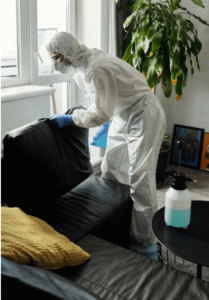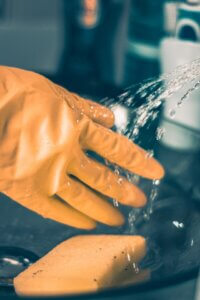How to Complete a Mould Inspection with AllAces
How to Complete a Mould Inspection with AllAces
Summary
A mould inspection identifies and assesses mould presence in properties. Mould, a fungus thriving in damp environments, can damage structures and cause health issues like respiratory problems and allergies. Regular mould inspections can prevent costly damages and health risks. Steps for an inspection include preparing the area, checking for visible signs, testing for hidden growth, and acting on findings. AllAces Cleaning and Restoration offers professional mould inspections, using specialised equipment to detect mould, helping ensure a mould-free environment in homes or businesses.
A mould inspection is a process of identifying and assessing the presence of mould in a given environment. It is an important part of any home or business owner’s maintenance routine, as mould can cause significant damage to the structure and health of the occupants. AllAces Cleaning and Restoration provides professional mould inspection services that will ensure your home or business is free from mould.
What Is Mould?
Mould is a type of fungi that grows in damp, warm environments. It can be found in many places, including bathrooms, basements, and other areas where moisture accumulates. Mould can cause a variety of health problems, such as respiratory issues, asthma attacks, allergies, and more. It can also damage structures by eating away at walls and floors.
The Benefits of a Mould Inspection
A mould inspection is essential for anyone who wants to keep their home or business safe from mould. By performing regular inspections, you can identify any potential issues before they become serious problems. This will help you avoid costly repairs and health risks associated with mould growth. Additionally, a mould inspection will help you identify any areas where moisture may be collecting, allowing you to take steps to prevent future mould growth.
How to Perform a Mould Inspection
Performing a mould inspection is relatively simple and can be done in just a few steps. Here are the steps to follow when carrying out a mould inspection:
Step 1: Prepare the Area
The first step in performing a mould inspection is to prepare the area. Start by removing all furniture and items from the space that could potentially be harbouring mould. This includes rugs, curtains, bookshelves, clothing, bedding, etc. Once everything has been removed from the space, it’s time to move on to the next step.
Step 2: Inspect for Visible Signs of Mould
Once the area has been cleared of all items that could be hiding mould, it’s time to start looking for visible signs of mould growth. Look for discolouration on walls and ceilings, as well as any areas that appear damp or have an unusual smell. Pay special attention to any cracks or crevices that could be harbouring moisture or mould spores. If you find any signs of visible mould growth, it’s important to act quickly and contact a professional for assistance.
Signs of mould can include:
Visible Growth: This is the most obvious sign. Mould can appear in a variety of colours, including black, white, green, brown, or orange. It might look fluffy, velvety, or slimy.
Musty Odour: Mould often emits a distinct musty smell. Even if you don’t see visible mould but notice this smell, it could be hidden behind walls, above ceiling tiles, or under carpets.
Allergic Reactions: People who are sensitive to mould can experience symptoms like sneezing, itchy eyes, skin rashes, and a stuffy nose. If these symptoms are aggravated at home and ease off when you are elsewhere, it could indicate the presence of mould.
Respiratory Issues: Inhalation of mould spores can lead to respiratory problems, especially in individuals with asthma or compromised immune systems. Symptoms might include shortness of breath, chest tightness, and coughing.
Water Leaks: If you notice water stains or discolouration on walls, ceilings, or floors, it could be a sign of a moisture problem, and where there’s moisture, mould can grow.
Water Intrusion: Past flooding or persistent dampness in certain parts of your home can lead to mould growth.
Condensation: Excessive condensation on windows or walls is a sign of high humidity and can be conducive to mould growth.
Wall or Paint Peeling: Wallpaper or paint that is bubbling, cracking, or peeling can indicate the presence of moisture and potential mould growth behind it.
Step 3: Test for Hidden Mould Growth
Even if you don’t see any visible signs of mould growth, it’s still possible for there to be hidden mould in your home or business. To test for hidden mould growth, use a professional-grade air quality monitor or hire an experienced inspector from AllAces Cleaning and Restoration who can use specialised equipment to detect hidden sources of moisture and potential sources of mould growth.
Step 4: Act
Once you’ve identified any areas where there may be hidden sources of moisture or potential sources of mould growth, it’s important to act right away. Start by addressing the source of the moisture, this could mean fixing a leaking pipe or improving ventilation in the space, then use professional-grade cleaning products to remove any existing mould growth from surfaces. If necessary, you may also need to hire an experienced contractor who can repair any structural damage caused by the mould growth or help prevent future growth with specialised treatments such as anti-mould paint or sealants.
Regular Mould inspections are an essential part of maintaining a healthy home or business environment. By performing regular inspections and acting, when necessary, you can protect your property from costly repairs and health risks associated with mould growth. AllAces Cleaning and Restoration provides professional services that can help identify hidden sources of moisture and potential sources of mould growth so you can act right away. With our help, you can keep your home or business safe from dangerous mould growth for years to come!
FAQs
What is mould inspection and why is it important?
A Mould inspection refers to the process of identifying and assessing the presence of mould, especially toxic mould, in residential or commercial properties. It is crucial because prolonged exposure to certain types of mould can have health implications such as respiratory issues, allergic reactions, and other medical complications.
How is a professional mould inspection conducted?
A professional mould inspection generally involves several steps including a visual inspection, sampling, moisture assessment and a final report.
How often should I get my property inspected for mould?
It’s not necessary to have a regular schedule for a mould inspection unless you live in a high-humidity area or have experienced flooding or significant water damage. However, it’s a good idea to consider a mould inspection if:
- You notice signs of water damage or persistent dampness.
- You start to experience unexplained allergy symptoms or respiratory problems.
- You detect a musty odour in parts of your property.
- There has been recent flooding or water damage.
- You’re purchasing a new home or property and want to ensure it’s mould-free.
Why Choose AllAces?
If you’re concerned about potential sources of mould in your home or business, contact AllAces Cleaning and Restoration today for a comprehensive inspection service that will help identify any hidden sources of moisture or potential sources of mould growth so you can act right away! With more than 35 years of industry experience, we have the expertise to handle any level of mould infestation in both domestic and commercial properties with our comprehensive mould remediation services.



